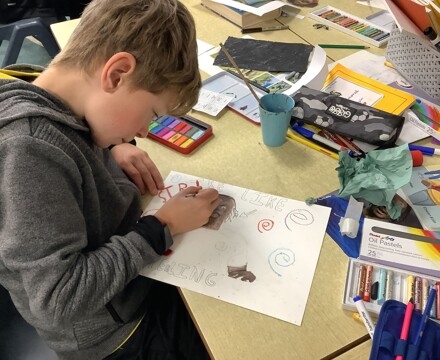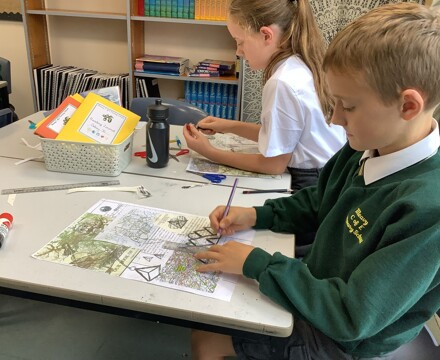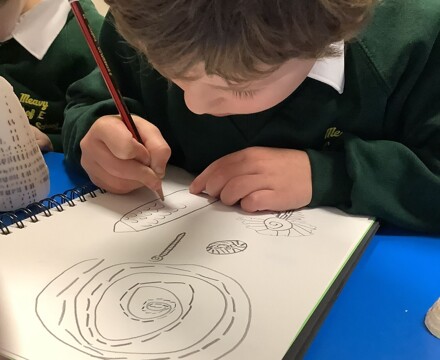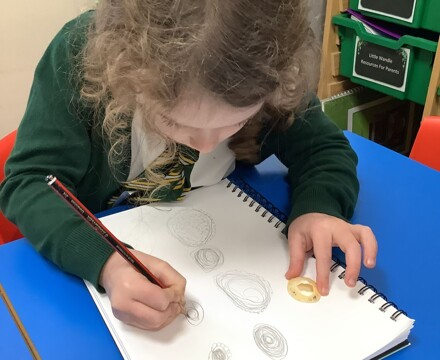- Home
- School Life
- Subjects
- Art and Design
Art and Design
Intent
At the West Dartmoor Federation our art curriculum is designed with the intent that our children will develop an appreciation and enjoyment of the visual arts.
High quality art education equips children with the skills to explore, experiment, create and invent their own work of art whilst engaging, inspiring and challenging pupils. As artists, children should be able to critically evaluate their work and the work of others.
At Meavy, we aim to inspire all children to express their individuality, thoughts and ideas through a variety of creative opportunities. At our school, art is an important part of the curriculum and we aim to encourage all children to appreciate and value great works of art, including historical and contemporary art as well as artefacts and images from other cultures.
We aim for children to show an appreciation and value of art, using art as a means to promote well-being and individuality. We aim for children to create confidently, drawing on their repertoire of skills and using a range of artistic mediums. We intend for children to feel pride in their creations by celebrating children’s outcomes on display around the school sharing finished artwork with visitors at our termly Meavy Museum and through joining local artists exhibiting at a public art festival.
Our art curriculum:
- is logical, broad and balanced in terms of the areas of subject content, inspiring a curiosity and fascination of how people can express themselves through a variety of media; exploring the ideas and meanings in the work of artists and designers, helping them learn about their different roles and about the functions of art and design in their own lives and in different times and cultures.
- is designed to encourage pupils to appreciate the beauty, order and precision that is found, naturally and man-made, in our world.
- is sequenced to ensure that pupils can build on previous knowledge whilst allowing them to experiment freely.
- is progressively more challenging from Years 1 through to 6, both in terms of the complexity of the subject knowledge we want our pupils to acquire and the skills they develop.
- is built upon and has continuity with the provision for art established in the Early Years Foundation Stage and in particular that which addresses the knowledge and skills expectations of the Expressive Arts and Design Early Learning Goal.
- is inclusive in terms of delivering the same curriculum to all of our pupils irrespective of specific learning needs or disabilities and differentiating where necessary.
Implementation
The curriculum is led and overseen by the art lead who liaises closely with the D&T lead. As art lead, a regular programme of monitoring, evaluation and review and the celebration of good practice will contribute to the ongoing commitment to evolve and improve further. Our art curriculum ensures coverage of the National Curriculum.
- All children follow a program of progressive skills in art and design.
- Wherever possible first-hand experiences and real things are used to stimulate art and design activities. New techniques and skills are modelled and worked examples are shown to the children.
- In group and individual work, pupils have the opportunity to investigate, explore and develop ideas and techniques. They are also involved in evaluating their work, celebrating success and identifying areas for improvement.
- We ensure that children have access to contemporary artists as well as more traditional ones, that are relevant to children today.
Impact
We measure the impact of our curriculum through the following methods:
- Collecting pupil voice, we aim for children to:
- create own artwork that they are proud of and reflects excellence for them
- develop a life-long love of art and the freedom and expression it provides
- develop awareness of the emotional impact the arts have on themselves and on an audience
- Feedback is given to children about certain aspects of their work or as questions for them to explore further – we do not write in the children’s sketchbooks but will provide feedback verbally.
- Reviewing the children’s understanding of topic-linked vocabulary before and after the unit is taught.
Assessment
Children are assessed against the national curriculum and skills maps throughout the year. Children’s ability to meet ARE in art is reported through an annual report to parents. Each teacher will refer to the previous year’s report when assessing a child’s current achievement in art and make their own judgement. This assessment is made based on observations of the children’s skills, completed submissions of learning at the end of a unit and a teacher’s overall judgement of a child’s aptitude.
Sketchbooks will show a comprehensive coverage of specific skills and demonstrate progression for individuals and across year groups, demonstrating children’s ability to:
-
Make progress with skills taught and revisited.
-
Express themselves in a range of ways and through a range of mediums.
-
Reflect on their own and others artwork.
Art in EYFS
The process and development of skills is valued equally to the final product and a balance of opportunities for children to explore process and not focus solely on final products are given to ensure a clear development of skills across the year.
Meavy C of E Primary School Progression Map
Meavy C of E Primary School Rolling Programme









































